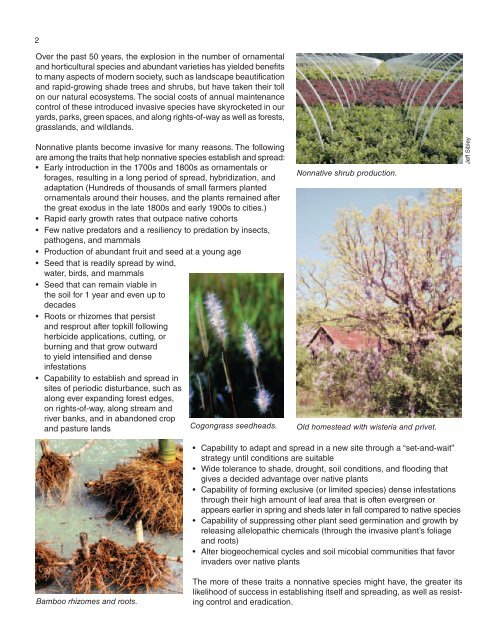2Over the past 50 years, the explosion <strong>in</strong> the number of ornamentaland horticultural species and abundant varieties has yielded benefitsto many aspects of modern society, such as landscape beautificationand rapid-grow<strong>in</strong>g shade trees and shrubs, but have taken their tollon our natural ecosystems. The social costs of annual ma<strong>in</strong>tenancecontrol of these <strong>in</strong>troduced <strong>in</strong>vasive species have skyrocketed <strong>in</strong> ouryards, parks, green spaces, and along rights-of-way as well as <strong>for</strong>ests,grasslands, and wildlands.Nonnative plants become <strong>in</strong>vasive <strong>for</strong> many reasons. The follow<strong>in</strong>gare among the traits that help nonnative species establish and spread:• Early <strong>in</strong>troduction <strong>in</strong> the 1700s and 1800s as ornamentals or<strong>for</strong>ages, result<strong>in</strong>g <strong>in</strong> a long period of spread, hybridization, andadaptation (Hundreds of thousands of small farmers plantedornamentals around their houses, and the plants rema<strong>in</strong>ed afterthe great exodus <strong>in</strong> the late 1800s and early 1900s to cities.)• Rapid early growth rates that outpace native cohorts• Few native predators and a resiliency to predation by <strong>in</strong>sects,pathogens, and mammals• Production of abundant fruit and seed at a young age• Seed that is readily spread by w<strong>in</strong>d,water, birds, and mammals• Seed that can rema<strong>in</strong> viable <strong>in</strong>the soil <strong>for</strong> 1 year and even up todecades• Roots or rhizomes that persistand resprout after topkill follow<strong>in</strong>gherbicide applications, cutt<strong>in</strong>g, orburn<strong>in</strong>g and that grow outwardto yield <strong>in</strong>tensified and dense<strong>in</strong>festations• Capability to establish and spread <strong>in</strong>sites of periodic disturbance, such asalong ever expand<strong>in</strong>g <strong>for</strong>est edges,on rights-of-way, along stream andriver banks, and <strong>in</strong> abandoned cropand pasture landsCogongrass seedheads.Nonnative shrub production.Old homestead with wisteria and privet.Jeff Sibley• Capability to adapt and spread <strong>in</strong> a new site through a “set-and-wait”strategy until conditions are suitable• Wide tolerance to shade, drought, soil conditions, and flood<strong>in</strong>g thatgives a decided advantage over native plants• Capability of <strong>for</strong>m<strong>in</strong>g exclusive (or limited species) dense <strong>in</strong>festationsthrough their high amount of leaf area that is often evergreen orappears earlier <strong>in</strong> spr<strong>in</strong>g and sheds later <strong>in</strong> fall compared to native species• Capability of suppress<strong>in</strong>g other plant seed germ<strong>in</strong>ation and growth byreleas<strong>in</strong>g allelopathic chemicals (through the <strong>in</strong>vasive plant’s foliageand roots)• Alter biogeochemical cycles and soil micobial communities that favor<strong>in</strong>vaders over native plantsBamboo rhizomes and roots.The more of these traits a nonnative species might have, the greater itslikelihood of success <strong>in</strong> establish<strong>in</strong>g itself and spread<strong>in</strong>g, as well as resist<strong>in</strong>gcontrol and eradication.
Recently escaped plants can rema<strong>in</strong> at low levels of scattered occurrence known as the “lag phase” but then come<strong>in</strong>to an era of rapid <strong>in</strong>creas<strong>in</strong>g spread. <strong>Invasive</strong> traits can be enhanced through hybridization with native or nonnativeplants of the same genus. There are nonnative plants at everystage of <strong>in</strong>vasion <strong>in</strong> the Southeast, while across the region noneare yet at the “maximum occupation” phase. Many currently “naturalized”plants <strong>in</strong> the early lag phase will likely become <strong>in</strong>vasivedue to selective adaptation and hybridization as well as <strong>in</strong>creaseddisturbed habitat <strong>for</strong> establishment.The objective of this book is to provide useful <strong>in</strong><strong>for</strong>mation on currentmanagement strategies and procedures <strong>for</strong> 56 recognized plantsthat have <strong>in</strong>vaded <strong>for</strong>ests, natural areas, pastures, rights-of-way,orchards, grasslands, and wetlands of the Eastern United States.This book also covers the pr<strong>in</strong>ciples of <strong>in</strong>vasion and how we canorganize, plan, and enact prevention and management programs.General Pr<strong>in</strong>ciples <strong>for</strong> Manag<strong>in</strong>g Nonnative<strong>Invasive</strong> <strong>Plants</strong>LandCoverandOccupationAll <strong>in</strong>vasive plantsare at some po<strong>in</strong>ton this graph of timeand occupationamount.RapidSpreadPhaseLag PhaseTimeMaximumOccupationAdaptive <strong>Management</strong> Cycle <strong>for</strong> an areaTreatAdaptive <strong>Management</strong> CycleArea Treatment <strong>for</strong> <strong>Invasive</strong> <strong>Plants</strong>Survey InputInputStakeholdersStakeholdersRestoreMonitor PlanInputStakeholdersSuccessRetreatRestoreEnvironmentalanalysisThree overarch<strong>in</strong>g concepts provide powerful ways to get organizedand counter <strong>in</strong>vasive plant takeovers: adaptation, collaboration,and restoration.• Adaptation, or adaptive resource management, generally refersto a community shared process of self-conscious learn<strong>in</strong>g bydo<strong>in</strong>g. The process <strong>in</strong>volves goal sett<strong>in</strong>g, ga<strong>in</strong><strong>in</strong>g experience andresearch f<strong>in</strong>d<strong>in</strong>gs, and monitor<strong>in</strong>g actions and outcomes withrapid <strong>in</strong>corporation of new knowledge <strong>in</strong>to ref<strong>in</strong>ed goals andactions. It is a corporate cyclical process of learn<strong>in</strong>g, adapt<strong>in</strong>g,and manag<strong>in</strong>g. It is a process of optimal decisionmak<strong>in</strong>g <strong>in</strong> theface of uncerta<strong>in</strong>ty, with an aim of reduc<strong>in</strong>g uncerta<strong>in</strong>ty overtime by monitor<strong>in</strong>g results of actions and careful adjustmentsto improve outcomes. We do not have all the solutions <strong>for</strong> fight<strong>in</strong>gthe <strong>in</strong>vasion of nonnative plant species, but, by pool<strong>in</strong>g our <strong>in</strong><strong>for</strong>mation resources, we can learn together howto improve our approaches and treatments. We must make full use of pr<strong>in</strong>t and Web resources, and we can becomeeven more effective by pay<strong>in</strong>g attention to new and <strong>for</strong>thcom<strong>in</strong>g <strong>in</strong><strong>for</strong>mation (see “Resource In<strong>for</strong>mation”on page 103).• Collaboration with adjacent and area landowners is essential because <strong>in</strong>vasive plant <strong>in</strong>festations most often occuracross ownership and political boundaries. For greatest effectiveness, we must develop and use communicationnetworks to l<strong>in</strong>k local, county, State, and regional programs.• Restoration of <strong>in</strong>fested lands to healthy and productive ecosystemsmust be our guid<strong>in</strong>g objective. We only can be successful with eradication,control, and conta<strong>in</strong>ment of <strong>in</strong>vasive plants through the establishmentof desirable and useful plants that protect soil, produce neededresources and habitats, and safeguard our lands from a resurgence of<strong>in</strong>vasive plants. We must identify, establish, and culture resistant andresilient plant communities on rehabilitated and restored lands, andthen we must monitor these communities <strong>for</strong> the first possible signsof return<strong>in</strong>g <strong>in</strong>vasive plants. Restoration approaches <strong>for</strong> most <strong>in</strong>vasiveplants are just be<strong>in</strong>g developed and will require adaptive managementcycles to perfect.Cooperative plann<strong>in</strong>g is critical.Inventory3
















